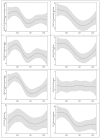The impact of the Covid-19 pandemic on the effectiveness of psychosomatic rehabilitation in Germany
- PMID: 38862923
- PMCID: PMC11165732
- DOI: 10.1186/s12913-024-11170-1
The impact of the Covid-19 pandemic on the effectiveness of psychosomatic rehabilitation in Germany
Abstract
Background: The aim of the present study is to investigate the impact of the Covid-19 pandemic on the effectiveness of psychosomatic rehabilitation.
Methods: Between April 2019 and March 2022, a total of 18,388 patients from 7 rehabilitation centres could be included in the study. For each patient, score values from the HEALTH-49 and ICF AT-50 Psych questionnaires were calculated at the beginning and at the end of rehabilitation and the effectiveness of the rehabilitation program was determined by comparing the scores at the beginning and at the end of the rehabilitation programme. Using risk adjusted linear mixed models, three time intervals were compared: a pre-pandemic episode (April 2019 to March 2020), the first year of the pandemic (April 2020 to March 2021) and the second year of the pandemic (April 2021 to March 2022).
Results: Overall, it can be stated that the pandemic has substantially impaired the effectiveness of psychosomatic rehabilitation measures. This phenomenon can be observed across a wide range of psychosocial markers and even two years after the start of the pandemic there is no end to the limited effectiveness. With regard to 'psychological and somatoform disorders', for example, there was a relative decrease in the effectiveness of the rehabilitation measure by 11.29% in the first year of the pandemic compared to the pre-pandemic episode, p < 0.001. In the second year of the pandemic, the effectiveness of the rehabilitation measure was still decreased by 8.8% compared to the pre-pandemic episode, p < 0.001. In addition, the evaluations show that a division of the pandemic effect into direct effects (on the individual) and indirect effects (via further complication of the occupational problem environment) can be made and that the pandemic-related complication of the occupational problem environment are still prevalent more than two years after the start of the pandemic.
Discussion: The Covid-19 pandemic has had a significant impact on the psychosomatic rehabilitation programs reducing the effectiveness of treatment not only for a short period of time but constantly until March 2022.
Trial registration number: DRKS00029669; Date of registration: 02/08/2022.
Keywords: Covid-19 pandemic; HEALTH-49; ICF AT-50 Psych; PAREMO; Psychosomatic rehabilitation; SIMBO-C.
© 2024. The Author(s).
Conflict of interest statement
The authors declare that they have no competing interests.
Figures


References
-
- Norris FH, Elrod CL. Psychosocial consequences of disaster. Methods Disaster Ment Health Res. 2006;20:42.
-
- De Quervain D, Amini E, Bentz D, Coynel D, Gerhards C, Fehlmann B. The Swiss Corona stress study. OSF preprints. Prepr Posted April. 2020;24.
MeSH terms
LinkOut - more resources
Full Text Sources
Medical
Miscellaneous

